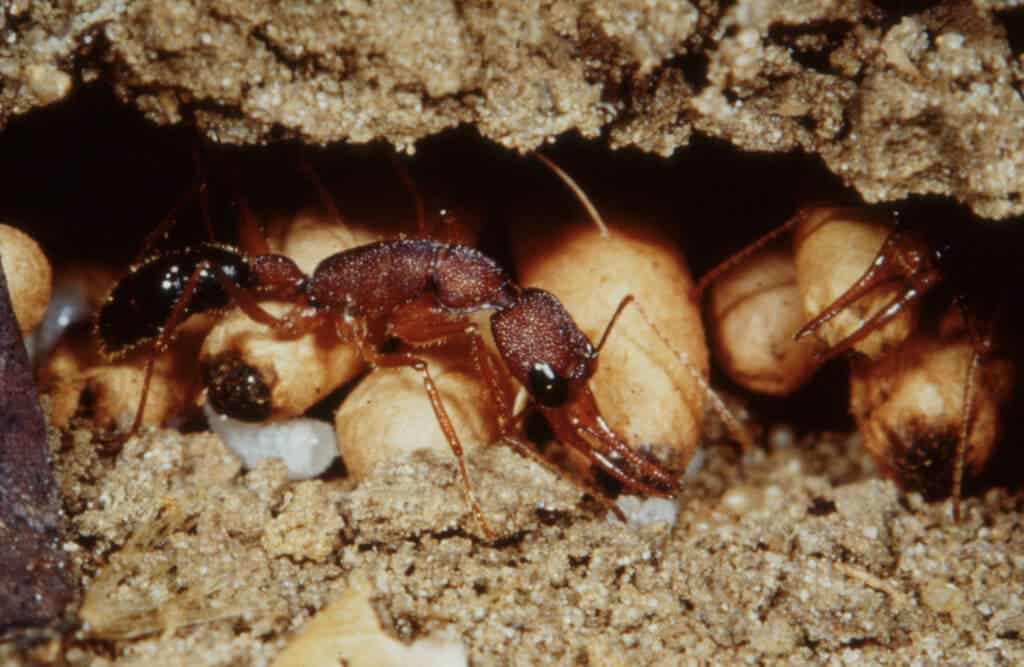Animal brains are plastic, they can change their structure and function. But some ants take this to a pretty extreme level. Under some conditions, they can switch from a worker to a queen-like ant — and the key behind this change is governed by a single molecule.

In ant colonies, the queen’s main role is to lay eggs, while the workers, well, work. A colony of ants can contain more than one queen, depending on the species, but some species do something even more intriguing: they have ants that can lay eggs like queens. These “fake” queens are called gamergates.
In most ant species, workers are sterile, but in the others, gamergates reproduce in addition to queens. In some species, “normal” queens have been completely replaced by gamergates. But what makes a worker become an egg-laying gamergate, and how does this process take place exactly? To figure this out, a team of researchers studied ants from a species called Harpegnathos saltator (or the Indian jumping ant).
“Gamergates are workers that have taken over the social role of queens”, Robert Bonasio, of the University of Pennsylvania Perelman School of Medicine told ZME Science. It’s a “switch” between social roles, but also a physiological change. Although there are no physical changes observable from the outside, a lot of things do change on the inside. “For example, their ovaries become enlarged. Also, their brains are rewired to some extent,” explains Bonasio.
Bonasio and colleagues wanted to understand how turning certain genes “on” or “off” affect brain function and behavior. To do this, researchers had to devise a way to isolate ant neurons from ant brains and maintain them alive in plastic dishes and artificial culture medium. It’s a routine practice for mouse and rat research, but it’s much more difficult for insects. However, Dr. Janko Gospocic, the study’s first author came up with an important innovation.
“For a while, Janko was trying to make a culture medium by making extracts from ant pupae (i.e. freezing and homogenizing them) and then adding it to the cultured neurons,” Bonasio explains. “This proved to be impossible to sustain because of the sheer number of pupae required. Then he had a eureka moment. He thought that because ant and bees are relatively close cousins, it might work to substitute honeybee pupae in the recipe. Lo and behold, it worked. So the secret to healthy ant brains seems to be frozen honeybee smoothies!”.
Armed with this method, the team could study the underlying molecular mechanisms that cause this switch. They identified two hormones (juvenile hormone and ecdysone) that are present at different levels in the bodies of workers and gamergates. These hormones seem to produce distinct patterns of gene activation in the brains of the two castes. This was surprising, Bonasio says, because researchers were expecting to find one or more dedicated transcription factors (a protein that turns genes on or off) in workers and then a different set of transcription factors only active in gamergates. “It was interesting to find one that could play both roles,” Bonasio told ZME Science.
However, the surprise came when researchers found that both hormones influenced the cells by activating a single protein called Kr-h1. However, researchers caution that this isn’t the only switch responsible for turning a worker into a queen or vice versa.
“This is not to say that Kr-h1 is the only protein that regulates caste identity. These things typically are complex and Kr-h1 is likely one of many switches that control the social transition,” Bonasio says.
It’s hard to draw direct lines from invertebrates to humans, Bonasio says, but researchers can build on this study to understand brain plasticity and the mechanisms that govern it in different types of animals.
“Plasticity is of course very important for any brain, including ours, and loss of plasticity has negative consequences. It would be very exciting if we could find that proteins and hormones with similarities to those we found in ants are also at work in the mammalian brain, and we will certainly pursue this line of investigation in the future,” Bonasio concludes.
Journal Reference: Janko Gospocic, Karl M. Glastad, Lihong Sheng, Emily J. Shields, Shelley L. Berger, Roberto Bonasio. Kr-h1 maintains distinct caste-specific neurotranscriptomes in response to socially regulated hormones. Cell, 2021; DOI: 10.1016/j.cell.2021.10.006









